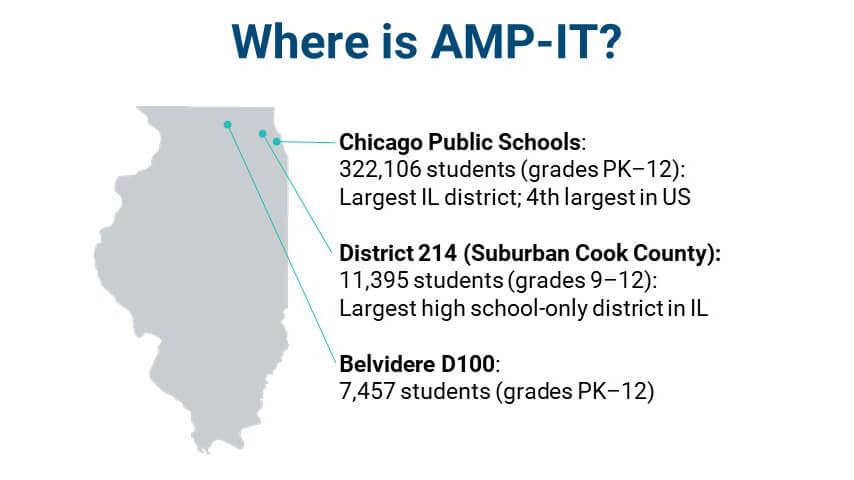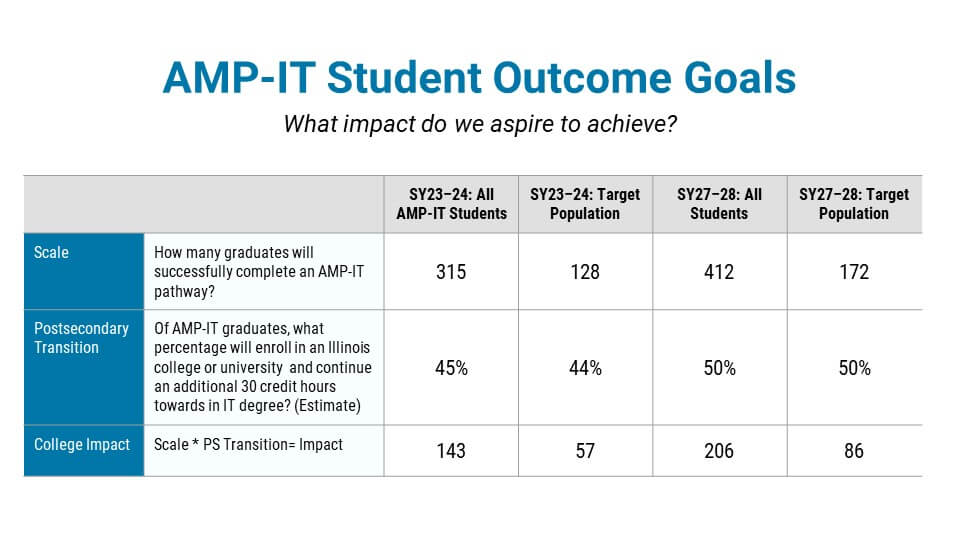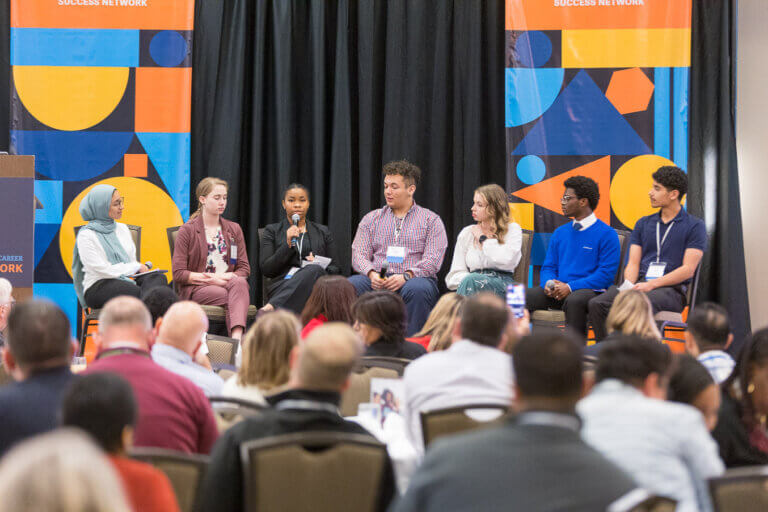Through our work supporting the implementation of the College and Career Pathway Endorsements system, EdSystems recognized the need to provide targeted support for IT pathways to scale the programs in response to employer demands more quickly. According to “The State of Chicago Tech Talent” report released by P33 in November 2021, the demand for tech talent in Illinois is “enormous and growing rapidly, making it a critical source of high-wage careers in the city’s 21st-century economy—and an opportunity to address racial disparities.” However, the tech industry does not often reflect the population. “Access to the best tech jobs is unequal… Colleges in Illinois and across the US produce computer science and other STEM graduating classes with too few Black, Latinx, and female graduates, reproducing and exacerbating race and gender divides that start in K-12 education, which ensures that these divides are reproduced downstream inside companies.”
With generous support from the Bill & Melinda Gates Foundation through the Accelerate Ed Initiative, EdSystems launched the Accelerated Model Pathways for Information Technology (AMP-IT) project in early 2022. The first cohort included Chicago Public Schools, District 214, and Belvidere District 100 and their community college and employer partners, together with our partners Code Nation, Discovery Partners Institute of the University of Illinois System, and P33. Together, we worked to design an accelerated IT pathway through a six-month design sprint, followed by support for implementation.
Based on the design, AMP-IT pathway students gain access to the skills and credentials needed to build confidence and be accelerated towards living-wage careers. This includes:
-
- Earning 15 to 30 hours of early college credit in high school, including at least six career-focused IT courses plus general education courses.
-
- Supported transition into aligned postsecondary programs at the districts’ community college or university partners.
-
- Earning an associate degree or 30 college credit hours towards an IT degree by year 13.
-
- Taking part in a continuum of meaningful work-based learning opportunities.
To support the diversification of the IT industry, each district identified target populations at the cross-section of underrepresentation in IT and their district goals for college attainment.
-
- Chicago Public Schools: Black and Latinx men
-
- District 214: English language learners, diverse learners, low-income students, and women
-
- Belvidere District 100: Women
In the first cohort, EdSystems is supporting the implementation of AMP-IT pathways in 19 total high schools. Chicago Public Schools offers the IT pathway at ten schools, providing them with annual funding to support work-based learning, textbooks, and teacher training. In District 214, a robust IT pathway is available to students at all six comprehensive high schools and one alternative school. It begins with a year-long Freshmen Orientation Seminar in which students learn about industries, set goals, and support career and course selections. At Belvidere District 100, two comprehensive high schools offer IT pathways, primarily Networking, aligned to the College and Career Pathway Endorsement. D100 also implements a “Running Start” dual enrollment program for a small cohort of students earning general associate degrees by high school graduation; this program can be modified for IT pathway students. Through these efforts, we estimate that AMP-IT pathways will support 315 students across the three districts in the 2023–24 school year, scaling to 412 students by the 2027–28 school year.
What We Learned In Year One
At the start of the design sprint, the initial goal was to design IT pathways leading to 30 credit hours for all students. While there is a history of early college credit programs in Illinois leading to 30 credit hours and even associate degree attainment by high school graduation, those programs are typically small in scale and inequitable for several reasons. Illinois’s Dual Credit Policy Act is generally permissive; that is, high school faculty teach most dual credit courses qualified as community college adjuncts, allowing students to remain on their high school campus (referred to as “off-campus credits”). However, the number of off-campus credits allowable for any student seeking an associate degree is capped at 29. This limitation is due to the Higher Learning Commission’s accreditation requirements for designating an “additional location” where more than 50% of coursework for a degree program is delivered. Consequently, any 30-credit-hour pathway will require students to commute from their high school campus to the local college for at least some coursework, creating access and equity barriers. Students without reliable transportation or whose high schools and/or homes are a significant distance from the community college face challenges getting to class on time. Additionally, students taking part in work-based learning activities, such as internships or apprenticeships, struggle to accommodate the in-person requirement into their schedule (not to mention students who are involved in extracurriculars, after-school jobs, caring for family members, etc.).
Because of the policy and practical barriers, many of our AMP-IT districts are more focused on implementing 15+ early college credit hours by high school graduation. Internal research by the Northwest Educational Council for Student Success, of which Cohort 1 partner District 214 is a founding member, has found that students who earn 15 hours or more of college credit before graduating from high school are two times more likely to complete a postsecondary program. This research led several districts, including District 214, to organize their pathway programs around the “Power of 15.” In their pathway designs, students would complete state pathway requirements of at least six early college credit hours in industry-specific coursework, plus an additional six to nine college credits in science, English, and math, for a minimum total of 15 college credits. Through this practice, students have equitable access to dual credit, dual enrollment, or AP courses offered on their high school campus while reaching a threshold of early college credit that leads to proven postsecondary success. This approach is being echoed by Chicago Public Schools through its model pathways as a part of the Roadmap for College Success, informed partly by the limited scale and impact the district has achieved to date through its P-TECH-modeled schools.
Responding to Youth Voices
As part of the design process, AMP-IT team members from each district and EdSystems conducted empathy interviews with IT pathway students to hear directly about the students’ felt needs and potential barriers, as well as ideas for how to support them. Three key themes emerged. First, students’ academic decisions and persistence are influenced by a number of trusted parties, including teachers, friends, family, and school counselors. Second, students’ interests and decision-making are influenced by exposure to career opportunities and adults drawing explicit connections between students’ coursework and the impact this may have on their careers. Finally, when informed, students do consider their future career, income, and benefits when selecting courses and extracurricular activities. This shaped our design thinking in a number of important ways:
- The need for targeted training and marketing outreach for each stakeholder group, including descriptions of future earnings and benefits. Outreach to students, including career access, should begin as early as middle school.
- The integration of meaningful work-based learning to help students affirm their interest in the industry and gain valuable hands-on experiences and soft skills while earning social capital with industry employers.
- Ensuring the credentials earned through the pathway can lead to a living wage career at multiple exit points.
- Strengthening the transition from high school to various postsecondary institutions resulting from pathway participation, not just one postsecondary option.
To learn more about the work of our first cohort and the lessons learned, download the AMP-IT Blueprint.




